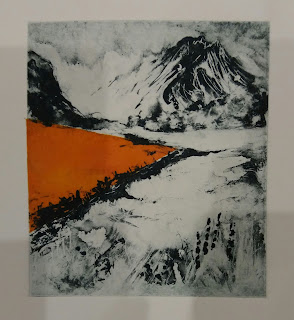For someone who loves trees (and
loves drawing trees.), I find myself sketching landscapes without trees
quite a lot. Many are coastal scenes, but hilly landscapes in this
region also tend to have few trees. I suppose it's inevitable in
these parts where the original tree cover was largely removed several
centuries ago. It's a legacy of our industrial heritage, mostly down to
shipbuilding and iron smelting, followed by sheep farming. Nowadays, the remaining shreds of our
native woodland are so precious that many of them are protected by
law.
Anyway, I love the wild windswept look of treeless landscapes: they motivate me to get down to a bit of sketching, even on a moody day like this.
I like that elemental feeling that you get from a landscape
pared down to its topographical purity, with perhaps the occasional
small plantation intruding here and there. However, in compositional
terms I can find these landscapes a challenge. The shape of a hill
becomes hugely important, as does its dominance within the scene.
And the overriding focus becomes colour and texture.
In spring I embarked on a few larger oil paintings. I love using oils but find them more of a challenge than acrylics, and often get a bit stuck. I was determined to produce a result.
Marsco (on Skye) is a hill with a beautiful angular shape. We have walked into Glen Sligachan several times and I always have to stop and sketch the view. Glen Sligachan is quite bleak – sandwiched between Marsco and Sgurr Nan Gillean – and perfect to allow the shape of the hill to become the focus of the scene.
I had already painted a couple of acrylic paintings from my sketches, but I was not altogether happy with these. I felt the colour was a little too realistic!
I made a start to an oil painting with some under-painting trying to get a feeling of lightness and that welcoming lure of the hills, and thinking about the marks to use in the treatment of the ground cover. The first layer ended up like this (below left).
Then I painted over this layer to get better depth of colour. All the time I was trying to maintain a similar palette and the lightness of colour. I also tried to improve on the composition by turning the river into a lochan and raising the height of Marsco to allow it to dominate in a more pleasing way.
So it ended up like this (below right).
Torridon is another largely treeless landscape. I find the
moorland behind (to the north of) Liathach and Beinn Eighe a great spot. The hills
rise directly out of the boggy floor, like ships on the sea. I have
sketched Beinn a Chearcaill several times, and painted it in acrylic, like this.
When it came to rendering the scene in oils, I decided to adjust the palette and use more of a geometric approach to the moorland, including the rocks. Initially I couldn't quite get the look I wanted, and then this misty mysterious look emerged, and that seemed to work. So that's why it has ended up like this.
However, the presence of such dominant hills takes the eye away from the emptiness of the moorland. I have realised that if I want to paint empty moorland scenes I have to think more about skies. So I have been working a bit harder of portraying clouds and skyscapes. Then I thought about developing this sketch I did in the Fisherfield area.
Working in acrylics, I realised that the composition (the emptyness) could be enhanced by adding more sky. I had done the sketch on a bright windy day with the clouds scudding across the sky and I sought to capture this in the sky.
These three finished paintings have found their way to a show in the Lemond Gallery, Bearsden (Glasgow) – the Big Christmas Show 2020. I got them nicely framed locally by Emma Noble in Kyle – she's done a great job. Look at the two oils!
Anyway - the work is all online at the Lemond Gallery which is now planning to reopen on Friday 11th to Monday 14th December for its final session (now that Covid-19 Rules permit!). If you would like to take a look, here's the link https://www.lemondgallery.com/

















